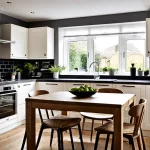Practical Layouts for Narrow UK Kitchens
Unlocking efficient small kitchen layout ideas
When tackling narrow kitchen design, choosing the right kitchen floor plans is crucial to maximize functionality. A galley layout remains a top choice, utilizing parallel countertops to create efficient work zones without wasting space. It’s ideal when kitchen width restricts alternative configurations. Another practical option is the L-shaped layout, which can allow room for a slim dining zone by extending one leg along a narrow wall, creating a visually open feel.
Also read : Top layout ideas to maximize your slender uk kitchen space
Integrating a dining area is often challenging but feasible. Consider a compact breakfast bar or fold-away table, which can blend seamlessly into the kitchen when not in use. This dual-purpose approach keeps space uncluttered and improves usability. Avoid cramming too many fixed cabinets, as they reduce movement and accentuate the cramped feeling.
Common pitfalls include neglecting sufficient clearance between work areas and the dining zone, which leads to uncomfortable traffic flow. Also, overly complicated floor plans with intricate island installations rarely suit narrow kitchens. Simplicity and measured design choices make small kitchen layout ideas truly practical for real daily use.
Also to see : Exploring the benefits of a galley layout for slim uk kitchens: why this design shines
Space-Saving Furniture for Dining
Maximise your dining area without compromising on style or comfort.
Choosing the right space-saving dining furniture is essential when dealing with limited square footage. Folding tables are a standout option. They can be extended for meals and neatly folded away to free space, ideal for multi-purpose rooms. Their adaptability suits changing needs, such as accommodating guests or switching between work and dining areas.
Another smart choice is breakfast bars. These provide a compact surface for eating or working, often doubling as extra kitchen counter space. Breakfast bars fit perfectly in kitchens or open-plan living spaces, maximising footprint efficiency.
For seating, bench seating is particularly versatile. Benches can slide under tables when not in use, clearing floorspace effortlessly. They’re often more compact than chairs and can accommodate different numbers of diners, adapting gracefully to shifts in household size or use.
Finding UK-available products means looking for designs balancing size, functionality, and style. Many contemporary manufacturers offer modular options that combine these features, making space-saving furniture not just practical but also appealing. This furniture transforms small dining areas into flexible, comfortable spots suited to daily life.
Smart Storage Solutions for a Clutter-Free Kitchen
Optimising every inch with clever design
When dealing with small kitchen storage, utilising vertical spaces is essential. Installing tall shelves or hanging racks helps transform underused zones into practical storage, clearing clutter from countertops and improving kitchen organisation. These spaces often accommodate frequently used items, boosting workflow efficiency by keeping essentials within easy reach.
Incorporating multifunctional storage options provides a dual benefit: more space and enhanced utility. Examples include cutting boards that slide over the sink or pull-out drawers with built-in compartments for utensils and spices. Such solutions maintain a clean, organised look while serving multiple purposes, which is pivotal in compact kitchens.
Hidden storage adds to a streamlined appearance and supports an uninterrupted cooking process. Cabinet doors with built-in racks or toe-kick drawers beneath lower cabinets keep tools and ingredients out of sight yet accessible. This clever use of space sustains momentum in the kitchen, avoiding needless interruptions.
By combining vertical space use, multifunctional storage, and concealed compartments, small kitchen storage can redefine your kitchen organisation and create a truly clutter-free environment.
Design Choices: Lighting, Colours, and Visual Tricks
Small or narrow kitchens benefit greatly from purposeful lighting, as proper illumination expands the perception of space. Using bright, evenly distributed lighting—such as under-cabinet LED strips or recessed ceiling lights—reduces shadows and highlights clean surfaces. This technique makes a narrow kitchen feel welcoming and open rather than cramped.
When choosing the best kitchen colours, light shades like soft whites, pale blues, or muted greys work well to reflect light and enlarge the room visually. Avoiding dark or saturated hues prevents the space from feeling closed in. Glossy or semi-gloss paint finishes further enhance light reflection and create an airy ambiance.
To visually expand a narrow kitchen, strategic tricks can be employed. Incorporating vertical stripes or elongated patterns on walls or backsplashes leads the eye along the room’s length, creating a sense of height and width. Moreover, using reflective surfaces such as mirrored backsplashes or glass elements adds depth. Positioning larger, unobstructed windows or opting for minimalistic cabinetry also opens up sightlines, subtly widening the space.
Such thoughtful choices in lighting for narrow kitchens, colours, and visual tactics significantly influence how spacious and inviting your kitchen feels.
Real-Life UK Kitchen Transformations
Inspiring examples from across the UK
UK kitchen inspiration often comes alive in small kitchen case studies that showcase ingenious use of space. Take, for instance, a London flat where a cramped kitchen was transformed by installing slimline appliances and clever storage solutions. This not only maximized functionality but maintained a sleek aesthetic, proving that size doesn’t limit potential.
Renovation success stories frequently highlight the importance of natural light. A Manchester home boosted theirs by fitting glass cabinet doors and light-coloured worktops, creating an airy feel despite limited square footage. Such choices demonstrate how lighting and colour can psychologically expand a small kitchen.
Experts emphasize practical features like pull-out shelves, integrated bins, and multi-purpose islands. These lessons learned reduce clutter and enhance workflow, key goals shared by homeowners navigating tight UK kitchen layouts. By studying these transformations, readers gain valuable insights into balancing style with day-to-day usability, particularly in space-constrained homes.
Whether motivated by efficiency or elegance, UK kitchen inspiration from these real cases offers adaptable ideas that can be tailored to various preferences and budgets.
Understanding Precision and Recall in SQuAD Evaluations
In the Stanford Question Answering Dataset (SQuAD), precision measures how many tokens in the prediction are correctly found in the ground truth answer. The formula is:
Precision tp / (tp + fp),
where tp stands for true positives—the shared tokens between prediction and correct answer—and fp represents false positives—tokens in the prediction but missing in the correct answer.
Similarly, recall captures how many relevant tokens from the correct answer appear in the prediction. It is expressed as:
Recall tp / (tp + fn),
with fn being false negatives—tokens present in the correct answer but absent in the prediction.
These metrics focus on token-level overlap, not just exact matches, offering a granular view of model performance. They highlight both the completeness (recall) and the accuracy (precision) of predicted answers. For instance, if a prediction contains excessive unrelated words, precision lowers despite matching key tokens. Conversely, if the prediction lacks essential tokens, recall suffers.
This dual evaluation is crucial for building reliable question-answering systems since it balances thoroughness and relevance in generated answers.


